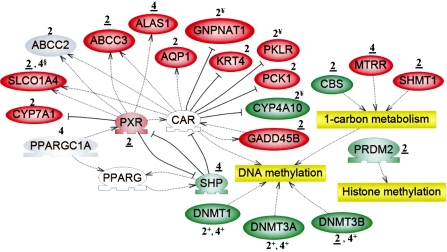FIG. 4.
The expression of genes involved in epigenetic-related processes, and those that are indicative of nuclear receptor activation, was altered by PB at 2 and 4 weeks. Microarray analysis was used to identify uniquely active genes in livers of tumor-susceptible B6C3F1 mice, as described in the “Methods.” Functional annotation of 367 uniquely active genes (Fig. 1; Supplementary Tables S3G–I) was performed. Regarding qRT-PCR analysis, a change was confirmed if the time point is underlined (data in Supplementary Tables S4–S5); gray indicates “not confirmed.” Expression of Slco1a4 was confirmed at 2, but not 4 (§) weeks. Genes noted as red or green that lack both underlining and particular symbols (+ and §) were not selected for confirmation. A plus sign (+) denotes a gene whose expression was evaluated only by qRT-PCR. White symbols represent “bridging” genes that were not altered in response to PB. Positive ( ) or negative (
) or negative ( ) regulation is illustrated, and the shapes of the entities represent the specific class of molecules to which the gene belongs: extracellular proteins (
) regulation is illustrated, and the shapes of the entities represent the specific class of molecules to which the gene belongs: extracellular proteins ( ) and transcription factors (
) and transcription factors ( ). According to Ueda et al. (2002), two genes (Krt4 and Pck1) exhibited CAR-dependent downregulation in response to PB (while we detected upregulation), and three genes (¥) were under CAR-dependent “blocking,” that is, they were induced or repressed only in CAR KO mice (versus the wild-type).
). According to Ueda et al. (2002), two genes (Krt4 and Pck1) exhibited CAR-dependent downregulation in response to PB (while we detected upregulation), and three genes (¥) were under CAR-dependent “blocking,” that is, they were induced or repressed only in CAR KO mice (versus the wild-type).

